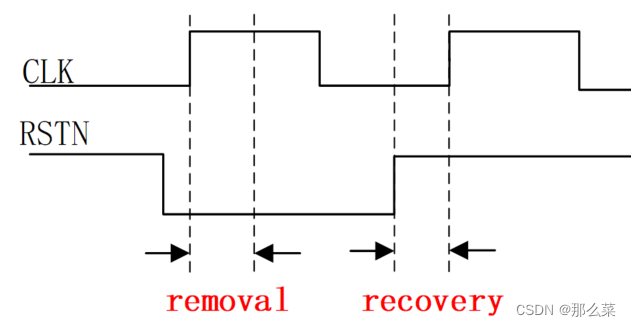热门标签
热门文章
- 1如何用 Python 做自动化测试【进阶必看】_python自动化测试
- 2docker打包容器 在另一个机器上运行_正在运行中的 dokcer 容器 打包
- 3【只推荐一位】木东居士,带着大家一起成长的数据科学大神!
- 4用TypeScript写贪吃蛇(完结):蛇身体的移动_ts贪吃蛇移动逻辑
- 5vue树形多列_vue单元格多列合并的实现
- 6解决找不到site-packages\torch\lib\shm.dll“ or one of its dependencies 问题_python shm one of its dependencies
- 7iOS面试:runtime如何实现weak变量的自动置nil?_runtime 是怎么实现weak置nil的
- 8Dockerfile执行from拉取基础镜像报错ERROR: failed to solve: java:8-alpine: failed to do request: Head “https://0_error: failed to solve: openjdk:8-jdk-alpine: fail
- 9Yarn JavaScript 包管理器介绍以及基本用法_yarn package.jason script
- 10LeetCode 300.最长上升子序列(超详细)_最长上升子序列算法leetcode
当前位置: article > 正文
后仿真中的 《specify/endspecify block》之(3)$recovery/ $removal 时序检查_$recrem recovery removal check
作者:喵喵爱编程 | 2024-08-19 11:59:11
赞
踩
$recrem recovery removal check
建立时间和保持时间的概念都是出现在同步电路的设计中。
对于异步复位的触发器来说,异步复位信号也需要满足 recovery time(恢复时间)和 removal time(去除时间),才能有效的复位和释放复位,防止出现亚稳态。
释放复位时,复位信号在时钟有效沿来临之前就需要提前一段时间恢复到非复位状态,这段时间为 recovery time。类似于同步时钟下触发器的 setup time。
复位时,复位信号在时钟有效沿来临之后,还需要在一段时间内保持不变,这段时间为 removal time。类似于同步时钟下触发器的 hold time。
recovery 与 removal time 示意图如下所示。

系统任务 $recovery 与 $removal 分别用于 recovery 和 removal time 的检查,用法如下:
$recovery (ref_event, data_event, recovery_limit) ;
- ref_event: 用于检查的参考信号,一般为清零或复位信号跳变沿;
- data_event: 被检查的信号,一般为时钟信号跳变沿。
- recovery_limit:设置的最小 recovery time。
当 ref_event (reset) < data_event (clock) 且 T(data_event - ref_event) < recovery_limit 时,即复位信号在时钟信号到来之前如果不满足 recovery time,则报告中会打印 violation。
$removal (ref_event, data_event, removal_limit) ;
- ref_event: 用于检查的参考信号,一般为清零或复位信号跳变沿;
- data_event: 被检查的信号,一般为时钟信号跳变沿。
- removal_limit:设置的最小 removal time。
当 ref_event (reset) > data_event (clock) 且 T(ref_event - data_event) > removal_limit 时,即复位信号在时钟信号到来之后如果不满足 removal time,则报告中会打印 violation。
Verilog 提供了同时检查 revomal 和 recovery 的系统任务:
$recrem (ref_event, data_event, recovery_limit, removal_limit);
声明:本文内容由网友自发贡献,不代表【wpsshop博客】立场,版权归原作者所有,本站不承担相应法律责任。如您发现有侵权的内容,请联系我们。转载请注明出处:https://www.wpsshop.cn/w/喵喵爱编程/article/detail/1002208
推荐阅读
相关标签


